Research
All truths are easy to understand once they are discovered; the point is to discover them.
– Galileo Galilei –
Friction, fault behavior
Investigators: Isabelle Lambert, Vicente Pena, and Nicola Tisato (Past Investigators: Ethan Conrad)
To better understand tectonic and fault behavior, we study the evolution of static and dynamic friction during rock deformation. Using rotary shear experiments, we study the evolution of fault slip surfaces, the precursory and co-seismic events that resemble natural earthquakes, and the types of materials that can be considered crustal analogs in tectonic sandbox experiments.
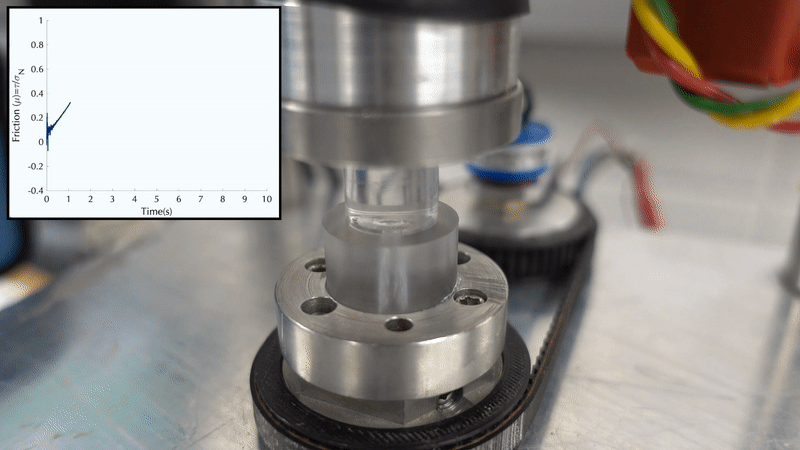 Above: Friction experiment with PMMA. Long displacement. Below: Long displacement stick-slip experiment with the Energy-Controlled Rotary Shear (ECoR) apparatus Below: A friction experiment on PMMA recorded with a high-speed camera at 10 kfps (panel below). The green area highlights the pseudotachilite or melt. Top: Mechanical data. |
The ECoR apparatus is also used to study friction in powders that are placed in a special sample holder that is equipped with a pressure sensor to link pore pressure to friction.
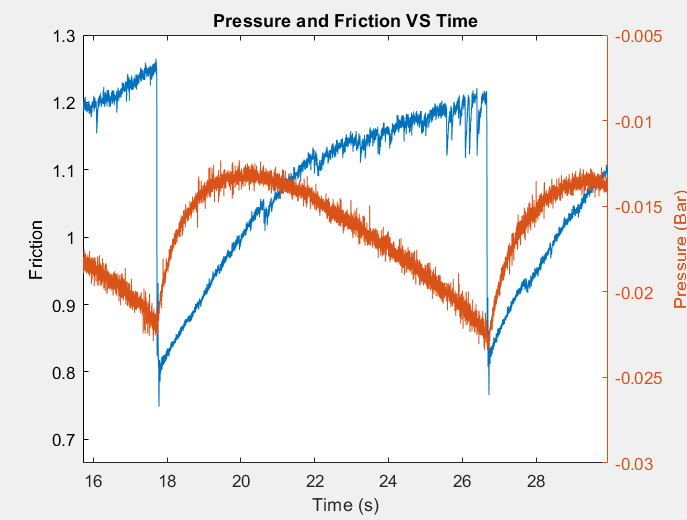 Stick-slip experiment on quartz-PVC powder used for analog experiments. Pressure shows the relative variation of pore-pressure in the powder (fault gouge). |
Video caption: Stick-slip experiment on quartz-PVC powder used for analog experiments. The black-green cable is the pressure sensor inserted in the powder.
Presentations:
De Ford Lecture THURSDAY SEPT 7, 2023 @4P CT, Nicola Tisato, Earthquakes Under the Lens of Rock Physics: Analog Materials to Rocks in the Field [link]
Selected references:
- Conrad, E. M.*, Tisato, N., Carpenter, B. M., & Di Toro, G. (2023) Influence of Frictional Melt on the Seismic Cycle: Insights From Experiments on Rock Analog Material. Journal of Geophysical Research: Solid Earth, 128, (19 pages). DOI: 10.1029/2022JB025695
- Zhao, Q., Glaser, S. D., Tisato, N., & Grasselli, G. (2020) Assessing Energy Budget of Laboratory Fault Slip Using Rotary Shear Experiments and Micro‐Computed Tomography. Geophysical Research Letters, 47, (9 pages). DOI: 10.1029/2019GL084787
This research topic is supported by the NSF project: Collaborative Research: High-velocity and long displacement stick-slips: Experimental analogs of earthquake rupture and the seismic cycle (#2240417) PI: Tisato, co-PI: Carpenter (OU).
Rock-physics to understand subduction zones
Investigators: Jacob Allen, Harm Van Avendonk (UTIG), Nathan Bangs (UTIG) and Nicola Tisato (Past Investigators: Carolyn Bland)
With this project, we have been studying the influence of rock elastic properties on the Hikurangi margin style of deformation. The North of the Hikurangi margin deforms slowly, often generating slow-slip events, while the South of the Hikurangi margin is locked, setting the conditions triggering a megathrust earthquake.
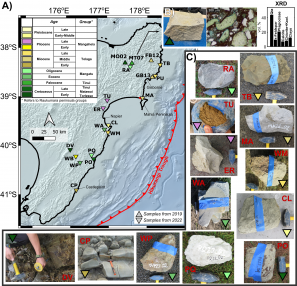 A) North Island of New Zealand. Position of the samples collected in 2019 and 2022. The symbol color indicates the age of the sample according to the legend. B) Picture, micro-photography, and XRD analysis of sample MT07(Tisato et al., 2023). C) Pictures of many of the samples collected in 2022. |
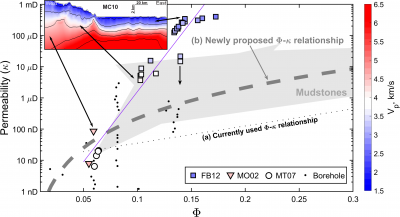 Summary of laboratory measurements: porosity, ultrasonic velocities, and permeability for samples FB12, MO02, and MT07 . Sample FB12 spans a large porosity range as it compacts during a compression test, mimicking the effect of subduction and accretion. Inset: seismic velocity model for the MC10 SHIRE section that agrees with ultrasonic velocities from laboratory measurements (double arrows). A newly proposed porosity-permeability relation (b) fits literature data on mudstone permeability better than a commonly used regression (a). |
Presentations:
De Ford Lecture THURSDAY SEPT 7, 2023 @4P CT, Nicola Tisato, Earthquakes Under the Lens of Rock Physics: Analog Materials to Rocks in the Field [link]
Selected references:
- Tisato N., C. D. Bland*, H. Van Avendonk, N. Bangs, O. Alamoudi*, K. Olsen, & Andrew Gase‡, Permeability and elastic properties of rocks from the northern Hikurangi margin: Implications for slow-slip events. Geophysical Research Letters, (19 pages). [link]
This research topic is supported by the NSF project: Study of the impact of seamount subduction on the outer wedge of the Hikurangi (# 1949171). PI: Van Avendonk, co-PI: Bangs, Tisato
Attenuation of seismic waves
Investigators: Isabelle Lambert and Nicola Tisato (Past Investigators: Sarah Al Nasser, Micheal McCann, Ziqi Jin, Ken Ikeda)
Attenuation describes the energy that elastic waves lose while traveling in a medium. Extrinsic attenuation is related to the geometrical spreading of the elastic energy carried by the wave, while intrinsic attenuation refers to the ability of specific mechanisms to convert the elastic energy of a wave into heat. The conditions at depth, such as the presence of fluids or the temperature, control these mechanisms. Thus measuring seismic wave attenuation and understanding the mechanisms provide insight into the subsurface. The main controls on the intrinsic attenuation in partially saturated rocks are Wave-Induced Fluid Flow (WIFF) and Wave-Induced-Gas-Exsolution-Dissolution (DOI: 10.3389/feart.2021.641177, DOI: 10.1002/2015GL063538). An interesting application is to study attenuation in magmatic chambers to understand when bubbles develop before an eruption (DOI: 10.1029/2020GL092315). We have developed a state-of-the-art attenuation apparatus, the Low-Frequency Module (LFM). LFM takes advantage of the sub-resonance technique to measure the frequency-dependent attenuation of rocks between 0.1 and 100 Hz (thesis).
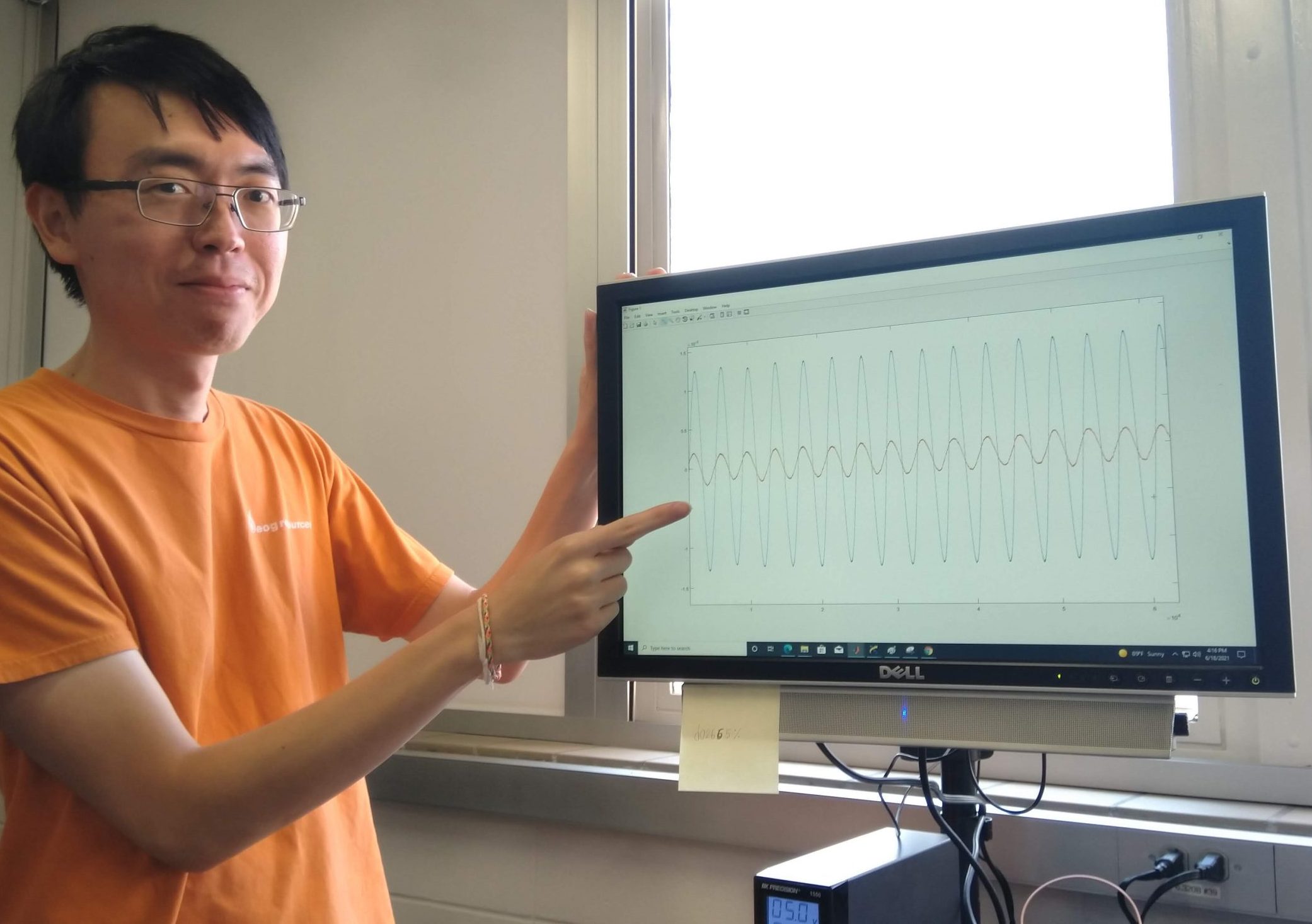 Ken Ikeda shows low-frequency force oscillation signals (nanometric vertical deformations) to estimate seismic wave attenuation in rocks measured with the low-frequecy module (LFM) shown on the right, |
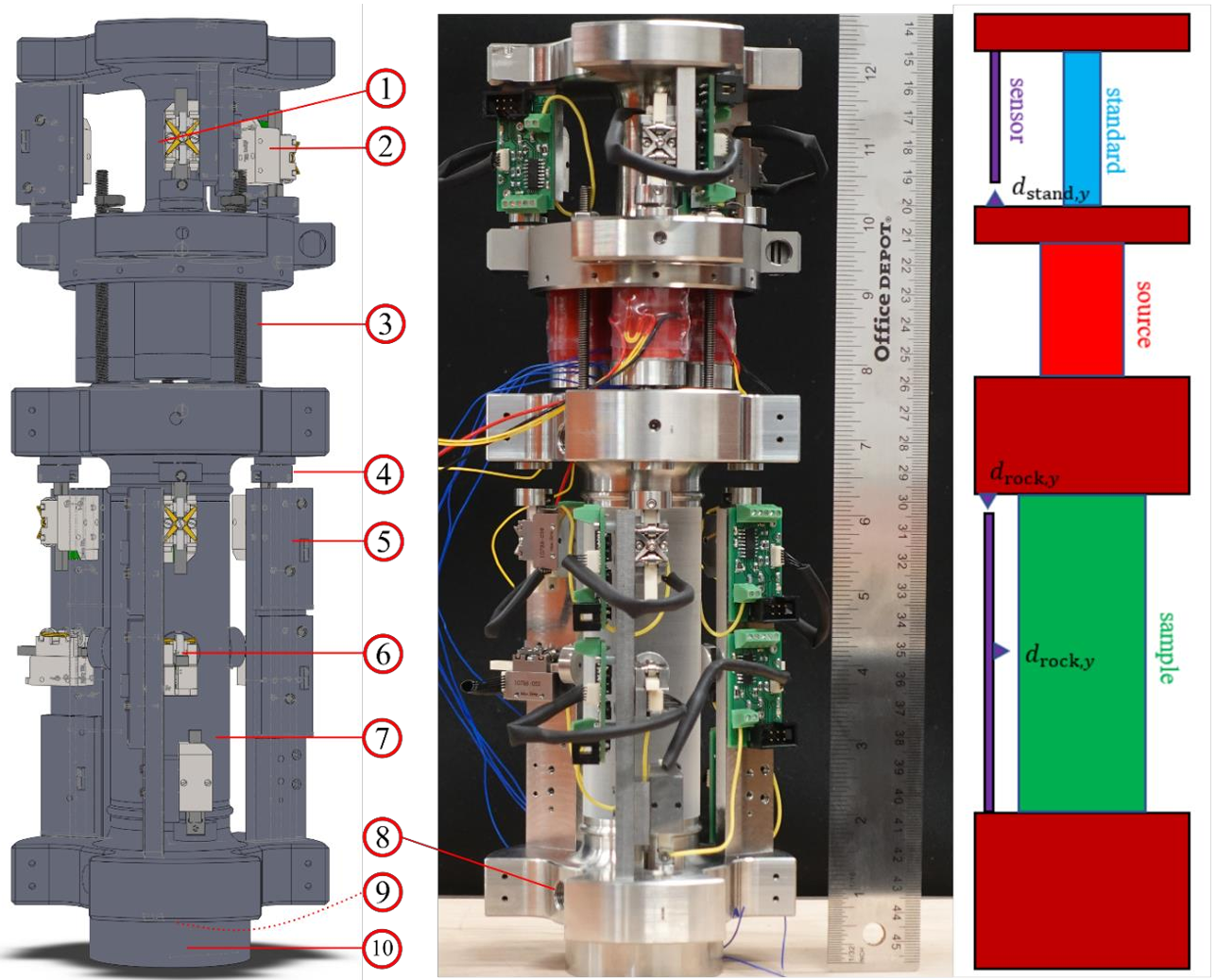 A schematic diagram of the LFM (left) along with the cross-section of the module (middle) and the simplified diagram indicating four main components (right). The number labels are: 1) standard titanium part, 2) piezo LEGS® Linear 6N and capacitive sensors [vertical standard], 3) PICA™ (Power Dynamics Piezo Actuators) actuator, 4) piezo LEGS® Linear 6N and capacitive sensors [vertical sample], 5) PCB boards, 6) piezo LEGS® Linear 6N and capacitive sensors [horizontal sample], 7) rock sample, 8) fluid inlet channel, 9) piezoelectric crystal chamber, and 10) spacer. |
Another interesting topic is the attenuation of seismic waves in fluids. We study the rheology of multiphase fluids, such as liquids with bubbles and viscous liquids. Bubbly fluids could be present in the subsurface due to hydrothermal processes, carbon-capture-sequestration, and hydrocarbon extraction (thesis). Viscous liquids such as water and guar can be used as proxies for magma and mud. We typically combine laboratory experiments with modeling to tackle physics.
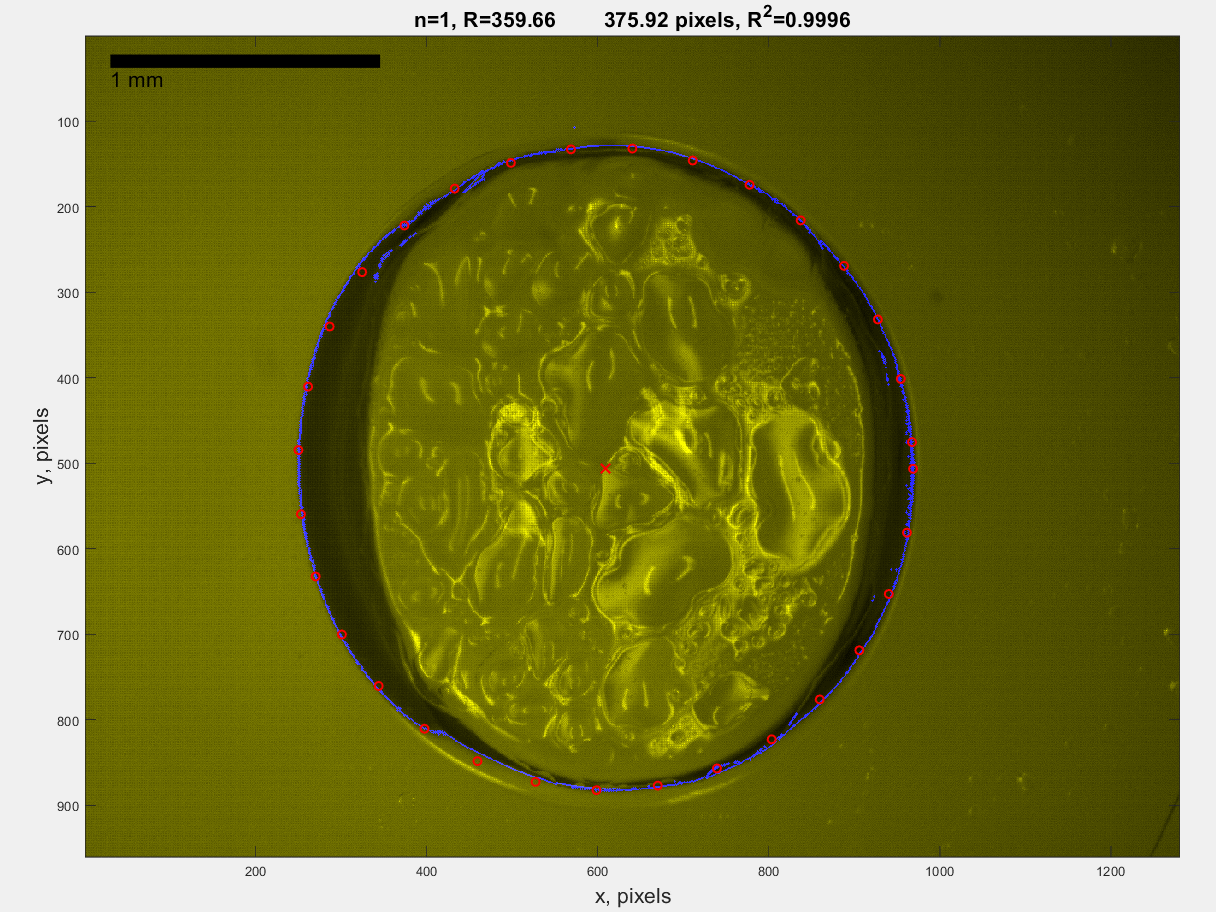 Bubble deforming as a consequence of a pressure step recorded with the WIGED apparatus. The Bubble rim is highlighted by the blue line and red dots. |
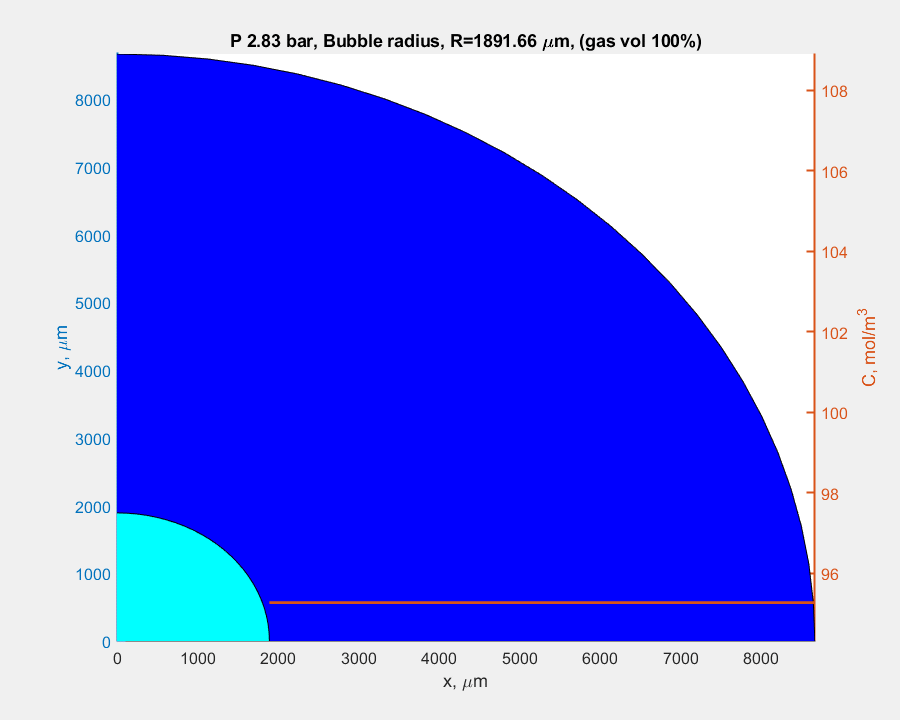 Numerical simulation of a CO2 bubble (cyan) in water (blue) deforming under a step of pressure. The red line shows the concentration (C) of CO2 in the water. |
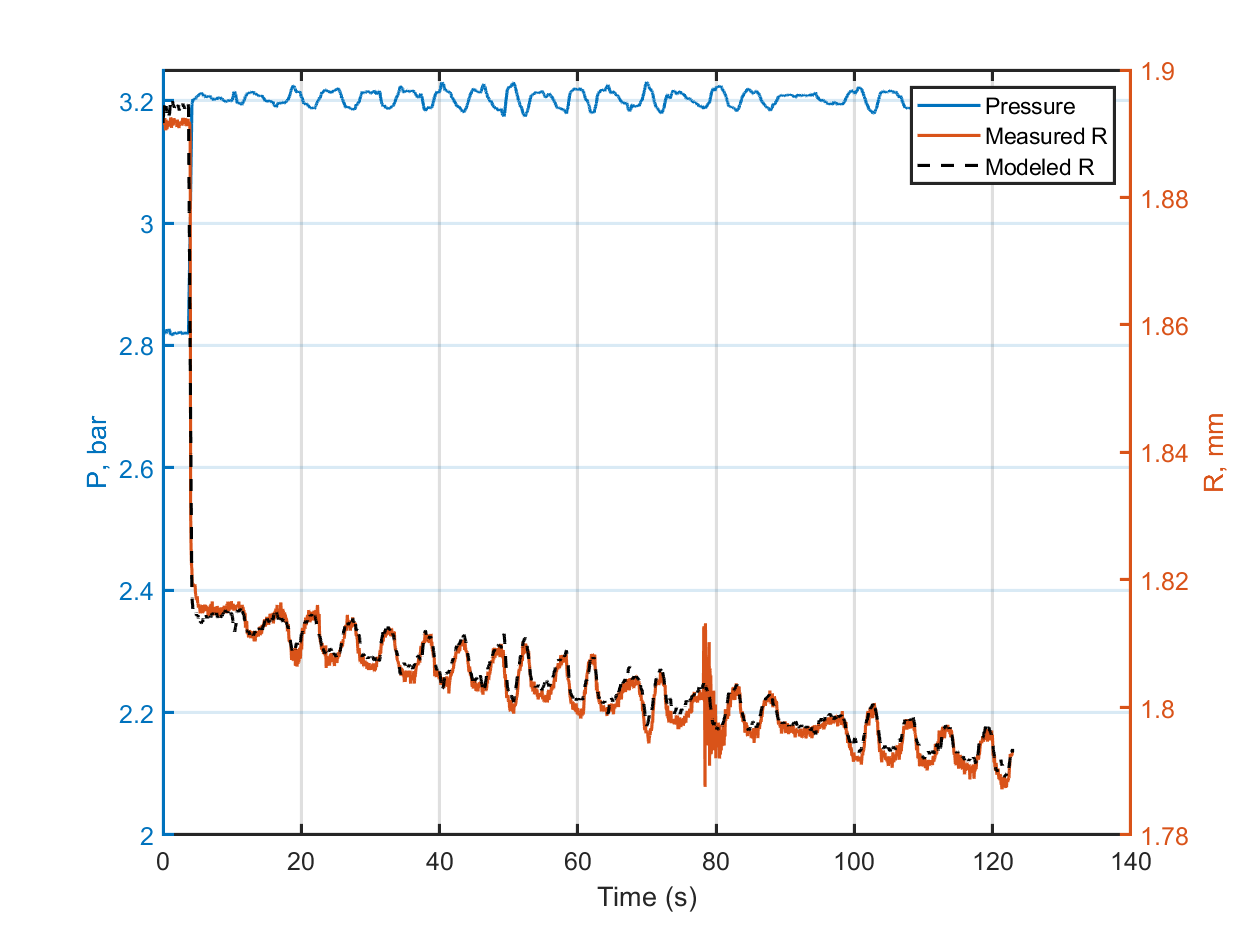
Results of a numerical simulation compared to the measurements taken with the WIGED apparatus
Presentations:
Selected references:
- Tisato, N., Madonna, C., & Saenger, E. H. (2021) Attenuation of Seismic Waves in Partially Saturated Berea Sandstone as a Function of Frequency and Confining Pressure. Frontiers in Earth Science, 9, (17 pages). DOI: 10.3389/feart.2021.641177
- Pistone, M., Fife, J. L., Tisato, N., Caricchi, L., Reusser, E., Ulmer, P., Mader K., & Marone F. (2021) Seismic Attenuation During Magma Vesiculation: A Combination of Laboratory Constraints and Modeling. Geophysical Research Letters, 48, (10 pages). DOI: 10.1029/2020GL092315
This research topic has been supported by the Edger forum (UT-private companies consortium).
CO2 mineralization in ultramafic rocks
Investigators: Clay Wood, Saleh Almeshari, and Nicola Tisato
The goal of this activity is to understand the chemo-physical processes occurring when carbon dioxide (CO2), water, and ultramafic rocks interact. A lot of interest revolves around such geological systems because when the CO2 is injected into such rocks (e.g., volcanic rocks similar/basalts), it forms solid minerals (carbonates) that will sequester the CO2 in the subsurface with no risk of leakage [link1 and link2]. In addition, the formation of such carbonates helps to weaken the ultramafic rocks that are often mined to obtain metals. To understand such processes, we inject carbonated water into rock core plugs of serpentinized dunite from Canada that are targets for Nickel extraction. While injecting the carbonated water, we monitor the emission of acoustic signals indicating the formation of cracks (mineralization-driven cracks), the changes in elastic properties, and the permeability of the rock. Using the X-ray transparent CO2 pressure vessel, we also observe the dissolution and precipitation of minerals happening as we concurrently inject the carbonated water and image the rock with a CT scanner.
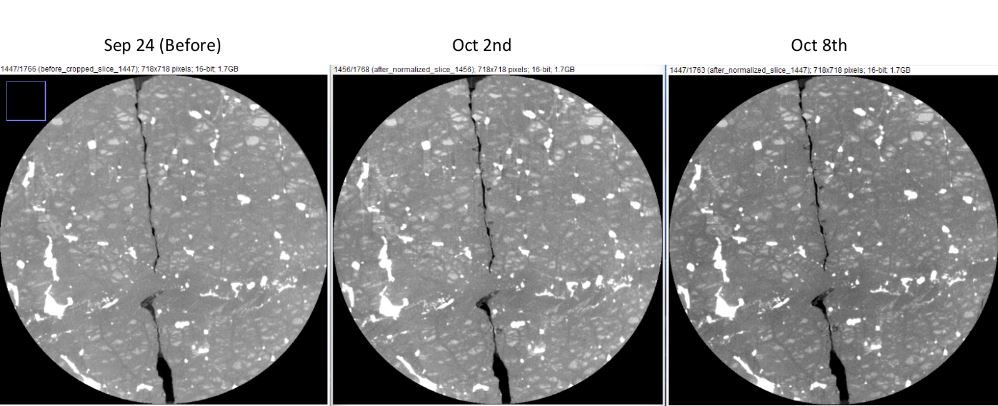
Horizontal slice of an X-ray tomography of a core sample (12 mm in diameter). The sample is an ultramafic rock and images were captured before and after injection of carbonated water. Notice the dark spots around the fracture on the slides of Oct 2nd and 8th. Such dark spots show dissolution.
This research has been supported by Canada Nickel and arpa-E MINER (PI Dr. Esti Ukar – BEG).
Combining rock-physics and micro-CT analyses (Digital Rock Physics)
Investigators: Omar Alamoudi, Saleh Almeshari, and Nicola Tisato (Past Investigators: Eric Goldfarb, Ken Ikeda)
We conduct experimental investigations combining tri-axial testing, micro-CT imaging, and ultrasonic velocities/acoustic emissions, and hydraulic permeability measurements. We use such a combination of methods to better understand the dependence of hydraulic permeability on varying stress, strain, and strain-rate on low-permeability sedimentary rocks such as shales and tight carbonates.
Understanding the mechanical behavior of rocks and their saturating fluid is critical to many geological and engineering fields. It is crucial to optimizing hydrocarbon exploration and development operations, CO2 storage and sequestration, improving geothermal energy yields, and understanding natural and human-made phenomena. Of particular importance is understanding the behavior of fractured geological materials, and the effect of stress on their hydraulic permeability. We reproduce overburden pressure and temperature conditions on rock samples by means of sealed tri-axial testing apparatus, leaving uncertainty on the sample mechanical behavior during the experiment. With the advent of micro-CT imaging, geologists and engineers can reduce such uncertainty by ‘visually’ inspecting the samples during tri-axial testing utilizing micro-CT imaging. Also, advanced micro-CT data analysis allows for the extraction of quantitative information about the rock sample during deformation.
Designing new methods to improve estimates of rock physical properties (e.g., density, porosity, and elastic properties) from analytical methods (e.g., micro-computed tomography: micro-CT). Read more…
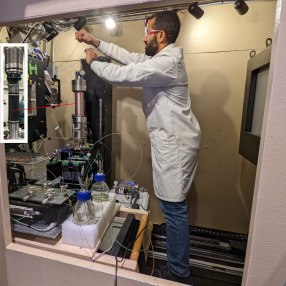 Omar Alamoudi mounting the X-Ray Transparent Pressure Vessel (X-RETTA) inside the X-ray scanner. The inset shows the sample assembly inside the X-RETTA. |
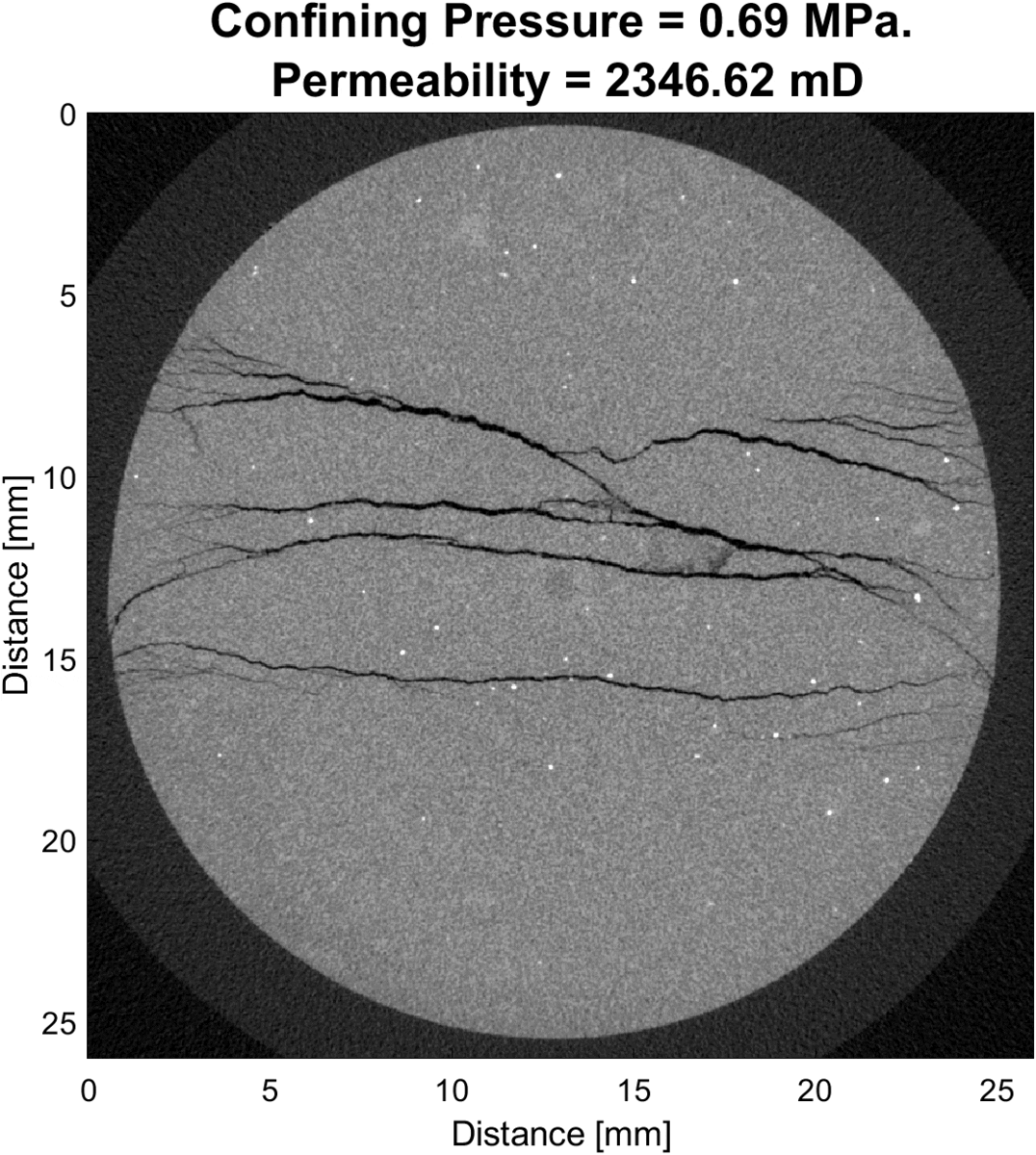 MicroCT slice of a 3D scan showing how fractures close and permeability changes as a function of confining pressure. The rock is a mudstone collected along the Hikurangi margin in New Zealand. |
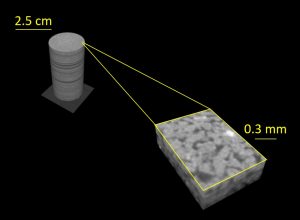 MicroCT Image Scaling |
 Simulation of ultrasonic wave propagation in Berea sandstone. |
Selected references:
- Ikeda, K., Goldfarb, E. J., & Tisato, N. (2020). Calculating Effective Elastic Properties of Berea Sandstone Using the Segmentation‐Less Method Without Targets. Journal of Geophysical Research: Solid Earth, 125(6). https://doi.org/10.1029/2019JB018680
- Chen, X., Espinoza, D. N., Luo, J. S., Tisato, N., & Flemings, P. B. (2020). Pore-scale evidence of ion exclusion during methane hydrate growth and evolution of hydrate pore-habit in sandy sediments. Marine and Petroleum Geology, 117, 104340. https://doi.org/10.1016/j.marpetgeo.2020.104340
- Ikeda, K.*, Subramaniyan, S., Quintal, B., Goldfarb, E. J.*, Saenger, E. H., & Tisato, N. (2021) Low-Frequency Elastic Properties of a Polymineralic Carbonate: Laboratory Measurement and Digital Rock Physics. Frontiers in Earth Science, 9, (15 pages). DOI: 10.3389/feart.2021.628544
- Goldfarb, E. J.*, Ikeda, K.*, Ketcham, R. A., Prodanović, M., & Tisato, N. (2022) Predictive digital rock physics without segmentation. Computers & Geosciences, 159, (12 pages). DOI: 10.1016/j.cageo.2021.105008
- Tisato N., K. T. Spikes, N. Saxena, & R. Hofmann, Scattering and Frequency Effects of Ultrasonic Velocities on Carbonates. Journal of Geophysical Research – Solid Earth, (39 pages). [link]
This research topic has been supported by Saudi Aramco, SNSF, DOE project: A multi-scale experimental investigation of flow properties in coarse-grained hydrate reservoirs during production. PI: Flemings, co-PIs: Daigle, Di Carlo, Espinoza, Phillips, Lin, Tisato, Zachary.
The genesis of cave deposits
Investigators: Carole Lakrout and Nicola Tisato
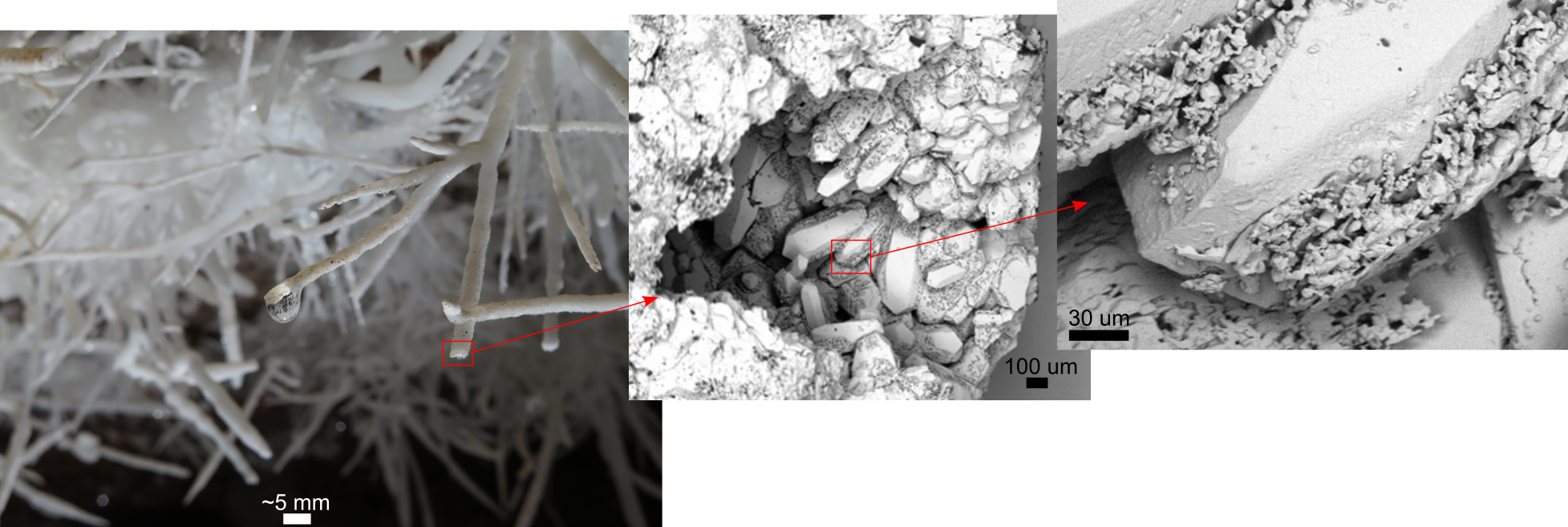
Helictites from Breezeway cave at different scales (Colorado -US). In the center and right image, the layer covering the calcite crystals is associated with the remnant of life activity.
Presentations:
- C.A. Lakrout, E.J. Goldfarb, T.R.R. Bontognali, and N. Tisato, Biotic influence in speleothems morphology, 3rd International Planetary Caves Conference scheduled for February 18–21, 2020 at Southwest Research Institute (SwRI), San Antonio (TX), https://www.hou.usra.edu/meetings/3rdcaves2020/
- Lakrout C. A.*, Jones N. T, Tisato N. (2022) Relating Unique Cave Structures to Micro-Biomes, LPI Contributions 2678, 2591, Houston, TX.
This research topic has been supported by the Center for Planetary Systems Habitability at UT Austin.
Development of an inexpensive yet accurate seismometer for seismic monitoring and outreach
Investigators: Looking for an undergrad student! Thorsten Becker, and Nicola Tisato (Past Investigators: Mason Currin)
We study the seismic waves generated by natural and anthropogenic events such as Longhorns football games (Hook’em!). We use a 3C 40 s, and a vertical 10 Hz, geophone-based seismometer. The latter is called BerryQuake and has been developed as an open-source design among the RDL. The collected data spans several months and includes 2019 season Longhorns football games, allowing us to compare crowd behavior during games and low noise periods, for example, during nights. Future studies might include deploying additional sensors to get a clearer picture of wave propagation from events.
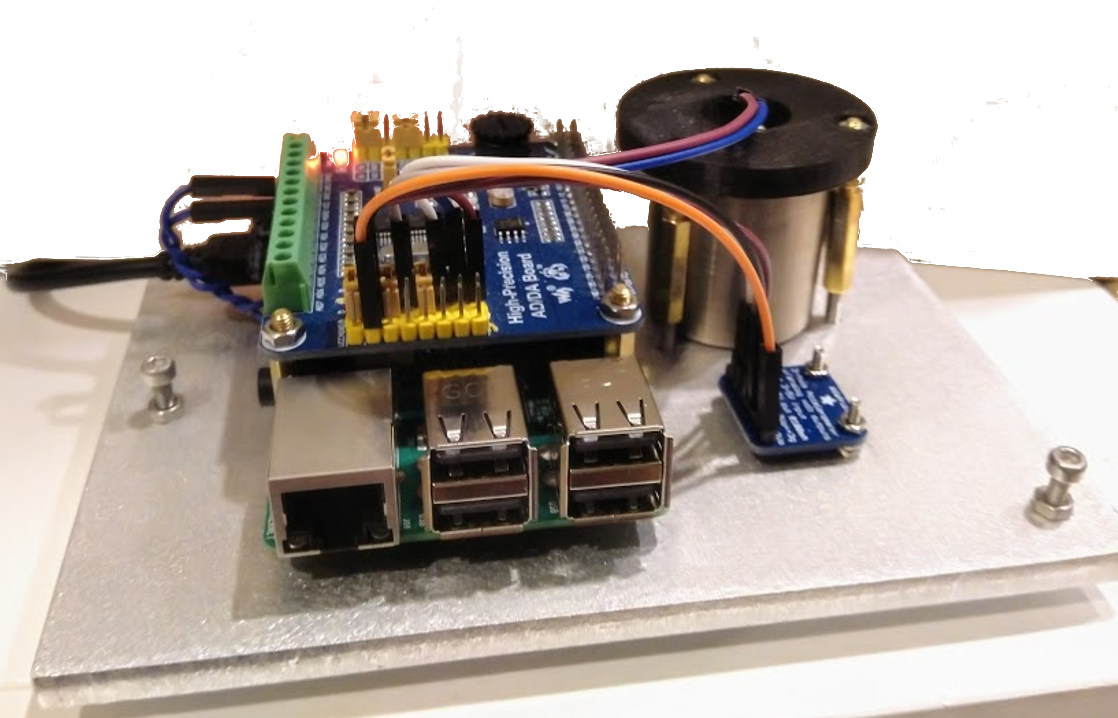
BerryQuake.

